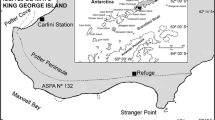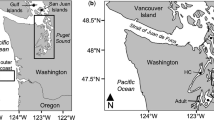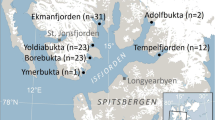Abstract
Harbour seals in Svalbard have short longevity, despite being protected from human hunting and having limited terrestrial predation at their haulout sites, low contaminant burdens and no fishery by-catch issues. This led us to explore the diet of Greenland sharks (Somniosus microcephalus) in this region as a potential seal predator. We examined gastrointestinal tracts (GITs) from 45 Greenland sharks in this study. These sharks ranged from 229 to 381 cm in fork length and 136–700 kg in body mass; all were sexually immature. Seal and whale tissues were found in 36.4 and 18.2%, respectively, of the GITs that had contents (n = 33). Based on genetic analyses, the dominant seal prey species was the ringed seal (Pusa hispida); bearded seal (Erignathus barbatus) and hooded seal (Cystophora cristata) tissues were each found in a single shark. The sharks had eaten ringed seal pups and adults based on the presence of lanugo-covered prey (pups) and age determinations based on growth rings on claws (≤1 year and adults). All of the whale tissue was from minke whale (Balenoptera acutorostrata) offal, from animals that had been harvested in the whale fishery near Svalbard. Fish dominated the sharks’ diet, with Atlantic cod (Gadus morhua), Atlantic wolffish (Anarhichas lupus) and haddock (Melanogrammus aeglefinus) being the most important fish species. Circumstantial evidence suggests that these sharks actively prey on seals and fishes, in addition to eating carrion such as the whale tissue. Our study suggests that Greenland sharks may play a significant predatory role in Arctic food webs.




Similar content being viewed by others
References
Andersen LW, Lydersen C, Frie AK, Rosing-Asvid A, Hauksson E, Kovacs KM (2011) A population on the edge: genetic diversity and population structure of the world’s northernmost harbour seals (Phoca vitulina). Biol J Linn Soc 102:420–439
Anon (1942) Beretninger vedrørende Grønlands Styrelse, sammendrag af statistiske oplysninger. afsnit 17, pp 647–652 (in Danish)
Beck BB, Mansfield AW (1969) Observations on the Greenland Shark, Somniosus microcephalus, in northern Baffin Island. J Fish Biol Board Can 26:143–145
Bigelow HB, Schroeder WC (1948) Sharks. In: Tee-Van J (ed) Fishes of the western North Atlantic, part 1. Sears foundation for Marine Research Yale University, New Haven, pp 59–546
Bowen WD, Ellis SL, Iverson SJ, Boness DJ (2003) Maternal and newborn life-history traits during periods of contrasting population trends: implications for explaining the decline of harbour seals (Phoca vitulina), on Sable Island. J Zool 261:155–163
Clark E, von Schmidt K (1965) Sharks of the central gulf coast of Florida. Bull Mar Sci 15(1):13–83
Clarke MR (1986) A handbook for the identification of cephalopod beaks. Clarendon Press, Oxford
Compagno L (1984) An annotated and illustrated catalogue of shark species known to date, pt 1: Hexanchiformes to Lamniformes. In: FAO species catalogue of the world, vol 4: sharks of the world. FAO Fish Synop 125, pp 1–249
Compagno LJV (2001) Sharks of the World. An annotated and illustrated catalogue of the shark species known to date. In: FAO species catalogue for fisheries purposes. No 1, vol 2, Bullhead, mackerel and carpet shark (Heterodontiformes, Lamniformes and Orectolobiformes). Rome, Italy
Cortés E (1997) A critical review of methods of studying fish feeding based on analysis of stomach contents: application to elasmobranch fishes. Can J Aquat Sci 54:726–738
Cortés E (1999) Standardized diet compositions and trophic levels of sharks. ICES J Mar Sci 56:707–717
Crovetto A, Lamilla J, Pequeño G (1992) Lissodelphis peronii, Lacépède 1804 (Delphinidae, Cetacea) within the stomach contents of a sleeping shark, Somniosus cf. pacificus, Bigelow and Schroeder, 1994, in Chilean waters. Mar Mamm Sci 8:312–314
Ferry LA, Cailliet GM (1996) Sample size and data analysis: are we characterizing and comparing diet properly? In: MacKinlay D, Shearer K (eds) Feeding ecology and nutrition in fish. American Fisheries Society, San Francisco, pp 71–80
Fisk A, Tittlemier SA, Pranschke JL, Norstrom RJ (2002) Using anthropogenic contaminants and stable isotopes to assess the feeding ecology of Greenland sharks. Ecology 83(8):2162–2172
Gjertz I, Lydersen C, Wiig Ø (2001) Distribution of diving habour seals (Phoca vitulina) in Svalbard. Polar Biol 24:209–214
Hall TA (1999) BioEdit: a user-friendly biological sequence alignment editor and analysis program for Windows 95/98/NT. Nucl Acids Symp Ser 41:95–98
Härkönen T (1986) Guide to the otoliths of the bony fishes of the Northeast Atlantic. Hellerup, Denmark
Hoel A (1949) Håkjerringfisket i Arktiske farvann (Greenland shark fisheries in Arctic waters). In: Strøm J (ed) Særtrykk av Norsk Fiskeri og Fangst Håndbok. Albert Cammermeyers, Norway, pp 823–828 (In Norwegian)
Hop H, Pearson T, Hegseth EN, Kovacs KM, Wiencke C, Kwasniewski S, Eiane K, Mehlum F, Gulliksen B, Wlodarska-Kowalczuk M, Lydersen C, Weslawski JM, Cochrane S, Gabrielsen GW, Leakey R, Lønne OJ, Zajaczkowski M, Falk-Petersen S, Kendall M, Wängberg S-Å, Bischof K, Voronkov AY, Kovaltchouk NA, Wiktor J, Poltermann M, di Prisco G, Papucci C, Gerland S (2002) The marine ecosystem of Kongsfjorden, Svalbard. Polar Res 21:167–208
Hyslop EJ (1980) Stomach content analysis—a review of methods and their application. J Fish Biol 17:411–429
Jensen AS (1914) The selachians of Greenland. Bianco Lunos Bogtrykkeri, København
Klekowski RZ, Weslawski JM (1991) Atlas of the marine fauna of southern Spitbergen, vol 2. Invertebrate part 1. Institute of Oceanography, Gdańsk
Klekowski RZ, Weslawski JM (1992) Atlas of the marine fauna of southern Spitbergen, vol 2. Invertebrate part 2. Institute of Oceanography, Gdańsk
Le Cren ED (1951) Length-weight relationship and seasonal cycle in gonad weight and condition in the perch (Perca fluviatilis). J Anim Ecol 20:201–239
LeBoeuf B, Riedman M, Keyes RS (1982) White shark predation on pinnipeds in California coastal waters. Fish Bull 80:891–895
Leclerc LM, Lydersen C, Haug T, Glover KA, Fisk AT, Kovacs KM (2011) Greenland sharks (Somniosus microcephalus) scavenge offal from minke (Balaenoptera acutorostrata) whaling operations in Svalbard (Norway). Polar Res 30:7342. doi:10.3402/polar.v30i0.7342
Liao CH, Pierce CL, Larscheid JG (2001) Empirical assessment of indices of prey importance in the diets of predacious fish. Trans Am Fish Soc 130:583–591
Lowe CG, Wetherbee BM, Crow GL, Tester AL (1996) Ontogenetic dietary shifts and feeding behaviour of the tiger shark, Galeocerdo cuvier, in Hawaiian waters. Envir Biol Fish 47:203–211
Lucas ZN, Natanson LJ (2010) Two shark species involved in predation on seals at Sable Island, Nova Scotia, Canada. Proc Nova Scotian Instit Sci 45:64–88
Lucas Z, Stobo WT (2000) Shark-inflicted mortality on a population of harbour seals (Phoca vitulina) at Sable Island, Nova Scotia. J Zool 252:405–414
Lydersen C, Kovacs KM (2005) Growth and population parameters of the world’s northermost harbour seals Phoca vitulina residing in Svalbard, Norway. Polar Biol 28:156–163
Lydersen C, Kovacs KM (2011) Status and biology of harbour seals (Phoca vitulina) in Svalbard. NAMMCO Sci Publ 8:47–60
McLaren IA (1958) The biology of the ringed seal (Phoca hispida Schreber) in the Eastern Canadian Arctic. Bull Fish Res Board Can 118:1–9
McMeans B, Svavarson J, Dennard S, Fisk AT (2010) Diet and resource use among Greenland sharks (Somniosus microcephalus) and teleosts sampled in Icelandic waters, using δ13C, δ15N, and mercury. Can J Fish Aquat Sci 67:1428–1438
Motta PJ, Wilga CD (2001) Advances in the study of feeding behaviors, mechanism, and mechanics of sharks. Envir Biol Fish 60:131–156
Nansen F (1924) Blandt sel og bjørn. Jacob Dybwads Forlag, Kristiania (In Norwegian)
Pinkas LM, Oliphant S, Iverson ILK (1971) Food habits of albacore, bluefin tuna and bonito in Californian waters. Cal Fish Game 152:1–105
Prestrud P, Gjertz I (1990) The most northerly harbor seal, Phoca vitulina, at Prins Karls Forland, Svalbard. Mar Mamm Sci 6:215–220
Ridoux V, Hall AJ, Steingrimsson G, Olafsson G (1998) An inadvertent homing experiment with a young ringed seal, Phoca hispida. Mar Mamm Sci 14:888–894
Secor DH, Dean JM, Laban EH (1992) Otolith removal and preparation for microstructural examination. Spec Pub. Can Fish Aquat Sci 117:19–57
Sigler MF, Hulbert LB, Lunsford CR, Thompson NH, Burek K, O’Corry-Crowe G, Hirons AC (2006) Diet of Pacific sleeper shark, a potential Steller sea lion predator, in the north-east Pacific Ocean. J Fish Biol 69:392–405
Snedecor GW, Cochran WG (1967) Statistical methods. The lowa State University Press, Iowa
Thompson PM, Van Parijs S, Kovacs KM (2001) Local declines in the abundance of harbour seals: implications for the designation and monitoring of protected areas. J Appl Ecol 38:117–125
van den Hoff J, Morrice MG (2008) Sleeper shark (Somniosus antarcticus) and other bite wounds observed on southern elephant seals (Mirounga leonina) at Macquarie Island. Mar Mammal Sci 24:239–247
Watt J, Pierce GJ, Boyle PR (1997) Guide to the identification of North Sea fish using premaxillae and vertebrae. ICES Coop Res Rep no 220
Wolkers H, Lydersen C, Kovacs KM (2004) Accumulation and lactational transfer of PCBs and pesticides in harbor seals (Phoca vitulina) from Svalbard, Norway. Sci Tot Environ 319:137–146
Yano K, Stevens JD, Compagno LJV (2007) Distribution, reproduction and feeding of the Greenland shark Somniosus (Somniosus) microcephalus, with notes on two other sleeper shark, Somniosus (Somniosus) pacificus and Somniosus (Somniosus) antarcticus. J Fish Biol 70:374–390
Acknowledgments
We thank G. Christensen, K. Frost, J.I. Karlsen, L. Lowry, H. Lund, B. McMeans, K. Molde, Y. Watanabe and the crew on RV Lance for their help in the field. In addition, we thank B. Bye for help with the map, and P. Haugen, L. Lindblom and B. Santos for help with analyses of the stomach contents, and Christoph Hahn for help in the laboratory with the genetics analyses. This work was funded by the Norwegian Polar Institute and the Norwegian Research Council’s Ocean and Coastal programme.
Author information
Authors and Affiliations
Corresponding author
Rights and permissions
About this article
Cite this article
Leclerc, LM.E., Lydersen, C., Haug, T. et al. A missing piece in the Arctic food web puzzle? Stomach contents of Greenland sharks sampled in Svalbard, Norway. Polar Biol 35, 1197–1208 (2012). https://doi.org/10.1007/s00300-012-1166-7
Received:
Revised:
Accepted:
Published:
Issue Date:
DOI: https://doi.org/10.1007/s00300-012-1166-7




